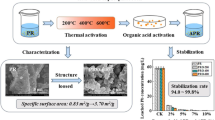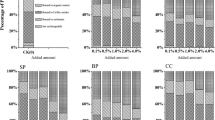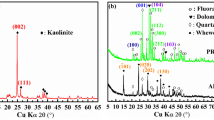Abstract
Phosphate amendments, especially phosphate rock (PR), are one of the most commonly used materials to stabilize heavy metals in contaminated soils. However, most of PR reserve consists of low-grade ore, which limits the efficiency of PR for stabilizing heavy metals. This study was to enhance the stabilization of heavy metals through improving the available phosphorous (P) release of PR by oxalic acid activation. Raw PR and activated PR (APR) were characterized by scanning electron microscopy-energy dispersive X-ray spectroscopy (SEM-EDS), X-ray powder diffraction (XRD), Brunauer–Emmett–Teller (BET) surface analysis, and laser diffraction to determine the changes of structure and composition of APR. The stabilization effectiveness of lead (Pb), zinc (Zn), and cadmium (Cd) in soils by APR was investigated through toxicity leaching test and speciation analysis. The results indicated that after treatment by oxalic acid, (1) the crystallinity of the fluorapatite phase of PR transformed into the weddellite phase; (2) the surface area of PR increased by 37%; (3) the particle size of PR became homogenized (20–70 μm); and (4) the available P content in PR increased by 22 times. These changes of physicochemical characteristics of PR induced that APR was more effective to transform soil heavy metals from the non-residual fraction to the residual fraction and enhance the stabilization efficiency of Pb, Zn, and Cd than PR. These results are significant for the future use of low-grade PR to stabilize heavy metals.





Similar content being viewed by others
References
Austruy A, Shahid M, Xiong T, Castrec M, Payre V, Niazi NK (2014) Mechanisms of metal-phosphates formation in the rhizosphere soils of pea and tomato: environmental and sanitary consequences. J Soil Sediment 14:666–678
Basta NT, Gradwohl R, Snethen KL, Schroder JL (2001) Chemical immobilization of lead, zinc, and cadmium in smelter-contaminated soils using biosolids and rock phosphate. J Environ Qual 30:1222–1230
Cao X, Ma LQ, Rhue DR, Appel CS (2004) Mechanisms of lead, copper, and zinc retention by phosphate rock. Environ Pollut 131:435–444
Cao X, Liang Y, Zhao L, Le H (2013) Mobility of Pb, Cu, and Zn in the phosphorus-amended contaminated soils under simulated landfill and rainfall conditions. Environ Sci Pollut Res 20:5913–5921
Chrysochoou M, Dermatas D, Grubb DG (2007) Phosphate application to firing range soils for Pb immobilization: the unclear role of phosphate. J Hazard Mater 144:1–14
Du Y, Wei M, Reddy KR, Jin F, Wu H, Liu Z (2014) New phosphate-based binder for stabilization of soils contaminated with heavy metals: leaching, strength and microstructure characterization. J Environ Manag 146:179–188
Du Y, Wei M, Reddy KR, Wu H (2016) Effect of carbonation on leachability, strength and microstructural characteristics of KMP binder stabilized Zn and Pb contaminated soils. Chemosphere 144:1033–1042
Elouear Z, Bouzid J, Boujelben N, Feki M, Jamoussi F, Montiel A (2008) Heavy metal removal from aqueous solutions by activated phosphate rock. J Hazard Mater 156:412–420
Fang Y, Cao X, Zhao L (2012) Effects of phosphorus amendments and plant growth on the mobility of Pb, Cu, and Zn in a multi-metal-contaminated soil. Environ Sci Pollut R 19:1659–1667
Guo G, Zhou Q, Ma Q (2006) Availability and assessment of fixing additives for the in situ remediation of heavy metal contaminated soils: a review. Environ Monit Assess 116:513–528
Hu N, Li Z, Huang P, Tao C (2006) Distribution and mobility of metals in agricultural soils near a copper smelter in South China. Environ Geochem Hlth 28:19–26
Jiang G, Liu Y, Huang L, Fu Q, Deng Y, Hu H (2012) Mechanism of lead immobilization by oxalic acid-activated phosphate rocks. J Environ Sci 24:919–925
Kohler J, Caravaca F, Carrasco L, Roldán A (2007) Interactions between a plant growth-promoting rhizobacterium, an AM fungus and a phosphate-solubilising fungus in the rhizosphere of Lactuca sativa. Appl Soil Ecol 35:480–487
Kpomblekou AK, Tabatabai MA (2003) Effect of low-molecular weight organic acids on phosphorus release and phytoavailabilty of phosphorus in phosphate rocks added to soils. Agric Ecosyst Environ 100:275–284
Li L, Holm PE, Marcussen H, Bruun HC (2014a) Release of cadmium, copper and lead from urban soils of Copenhagen. Environ Pollut 187:90–97
Li Z, Feng X, Bi X, Li G, Lin Y, Sun G (2014b) Probing the distribution and contamination levels of 10 trace metal/metalloids in soils near a Pb/Zn smelter in Middle China. Environ Sci Pollut Res 21:4149–4162
Li P, Lin C, Cheng H, Duan X, Lei K (2015) Contamination and health risks of soil heavy metals around a lead/zinc smelter in southwestern China. Ecotox Environ Safe 113:391–399
Liu Y, Feng L, Hu H, Jiang G, Cai Z (2012) Phosphorus release from low-grade rock phosphates by low molecular weight organic acids. J Food Agric Environ 10:1001–1007
Mignardi S, Corami A, Ferrini V (2012) Evaluation of the effectiveness of phosphate treatment for the remediation of mine waste soils contaminated with Cd, Cu, Pb, and Zn. Chemosphere 86:354–360
Ouahmane L, Revel JC, Hafidi M, Thioulouse J, Prin Y, Galiana A (2009) Responses of Pinus halepensis growth, soil microbial catabolic functions and phosphate-solubilizing bacteria after rock phosphate amendment and ectomycorrhizal inoculation. Plant Soil 320:169–179
Park JH, Bolan N, Megharaj M, Naidu R (2011) Comparative value of phosphate sources on the immobilization of lead, and leaching of lead and phosphorus in lead contaminated soils. Sci Total Environ 409:853–860
Perrone J, Fourest B, Giffaut E (2001) Sorption of nickel on carbonate fluoroapatites. J Colloid Interf 239:303–313
Rao CRM, Sahuquillo A, Sanchez JFL (2008) A review of the different methods applied in environmental geochemistry for single and sequential extraction of trace elements in soils and related materials. Water Air Soil Poll 189:291–333
Saxena S, D’Souza SF (2006) Heavy metal pollution abatement using rock phosphate mineral. Environ Int 32:199–202
Scheckel KG, Diamond GL, Burgess MF, Klotzbach JM, Maddaloni M, Miller BW (2013) Amending soils with phosphate as means to mitigate soil lead hazard: a critical review of the state of the science. J Toxicol Env Heal B 16:337–380
Ström L, Owen AG, Godbold DL, Jones DL (2005) Organic acid behaviour in a calcareous soil implications for rhizosphere nutrient cycling. Soil Biol Biochem 37:2046–2054
US EPA (1986) Method 1311 toxicity characteristic leaching procedure (TCLP). United States Environmental Protection Agency
Waterlot C, Pruvot C, Ciesielski H, Douay F (2011) Effects of a phosphorus amendment and the pH of water used for watering on the mobility and phytoavailability of Cd, Pb and Zn in highly contaminated kitchen garden soils. Ecol Eng 37:1081–1093
Wei M, Du Y, Reddy KR, Wu H (2015) Effects of freeze-thaw on characteristics of new KMP binder stabilized Zn- and Pb-contaminated soils. Environ Sci Pollut R 22:19473–19484
Wu W, Xie Z, Xu J, Wang F, Shi J, Zhou R (2013) Immobilization of trace metals by phosphates in contaminated soil near lead/zinc mine tailings evaluated by sequential extraction and TCLP. J Soil Sediment 13:1386–1395
Xu Y, Schwartz FW, Traina SJ (1994) Sorption of Zn2+ and Cd2+ on hydroxyapatite surfaces. Environ Sci Technol 28:1472–1480
Zhang W, Ma W, Ji Y, Fan M, Oenema O, Zhang F (2008) Efficiency, economics, and environmental implications of phosphorus resource use and the fertilizer industry in China. Nutr Cycl Agroecosys 80:131–144
Zhang Z, Guo G, Teng Y, Wang J, Rhee JS, Wang S (2015) Screening and assessment of solidification/stabilization amendments suitable for soils of lead-acid battery contaminated site. J Hazard Mater 288:140–146
Zhang Z, Ren J, Wang M, Song X, Zhang C, Chen J (2016) Competitive immobilization of Pb in an aqueous ternary-metals system by soluble phosphates with varying pH. Chemosphere 159:58–65
Zhu J, Cai Z, Su X, Fu Q, Liu Y, Huang Q (2015) Immobilization and phytotoxicity of Pb in contaminated soil amended with γ-polyglutamic acid, phosphate rock, and γ-polyglutamic acid-activated phosphate rock. Environ Sci Pollut R 22:2661–2667
Funding
We are grateful to the National High Technology Research and Development Program of China (“863” program) (2012AA101402) and the National Natural Science Foundation of China (Grant No. 41071165) for their financial support for this research.
Author information
Authors and Affiliations
Corresponding author
Additional information
Responsible editor: Zhihong Xu
Rights and permissions
About this article
Cite this article
Zhang, Z., Guo, G., Wang, M. et al. Enhanced stabilization of Pb, Zn, and Cd in contaminated soils using oxalic acid-activated phosphate rocks. Environ Sci Pollut Res 25, 2861–2868 (2018). https://doi.org/10.1007/s11356-017-0664-0
Received:
Accepted:
Published:
Issue Date:
DOI: https://doi.org/10.1007/s11356-017-0664-0




